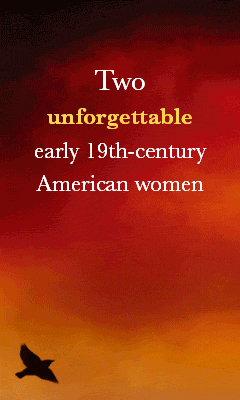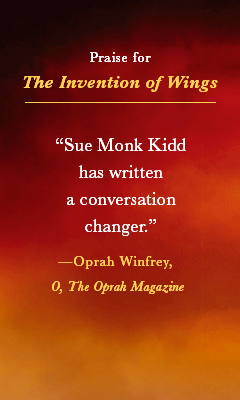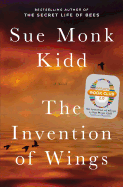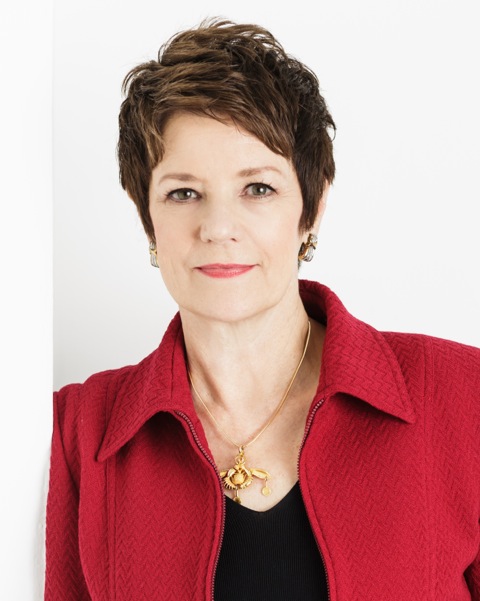The Invention of Wings
by Sue Monk Kidd
The Invention of Wings opens in 1803, on Sarah Grimké's 11th birthday. To mark the occasion, her mother gives her an unwanted birthday gift: the awkwardly beribboned 10-year-old Hetty Grimké--Sarah's very own slave. Sarah is repulsed and tries to free Hetty that very night with a document she draws up herself, but it isn't that easy for the child of one of Charleston, S.C.'s first families. The two girls grow into womanhood bound together but separated by the chasm of their very different circumstances.
Sue Monk Kidd, author of The Secret Life of Bees and co-author of Traveling with Pomegranates, chooses to tell this story in first person and to alternate between the voices of Hetty and Sarah--one of many masterful choices that make The Invention of Wings a remarkable read. The name "Hetty" was given by her owners; Hetty is called Handful by her mother, Charlotte, to whom she is devoted. One of the novel's richest characters, Charlotte tells her daughter only parts of her own past: stories of Handful's father, who never saw his daughter's face, and of Charlotte's own mother, who was brought to Charleston and slavery from Africa when she was a small girl. Charlotte teaches Handful to sew, to make very fine clothes and quilts. This artistry earns them both a relatively privileged place in the household and, importantly, provides a means of recording stories among slaves, for whom literacy was illegal. Charlotte sews her daughter a story quilt, appliqueing squares that tell of her life's greatest events. This rich storytelling tradition is described in Handful's passionate voice, which both contrasts with and matches Sarah's, also passionate, as she experiences limitations of a different sort. An intelligent child encouraged by a father and brother to read books, she harbors dreams of becoming a barrister, which are inevitably dashed against Charleston's expectations of a young lady. Her inclination to teach slave children to read is likewise reviled, although she succeeds in secret with Handful. Over the years, the two girls share confidences across a wary divide, but guilt and resentment present obstacles to their friendship.
When the girls are still very young, Charlotte extracts a promise from Sarah: that she will free Handful one day. This promise haunts Sarah, who will eventually journey north to escape her stifling family and the peculiar institution she despises. She meets a Quaker man, whose own peculiar religion at first repels her but comes to fascinate and draw her in; this new alliance shapes Sarah's more independent adult life, and distances her from Handful, who necessarily remains in Charleston. Along with her indubitable younger sister, Nina, Sarah will finally become a renowned (and infamous) activist for abolition and women's rights. Overcoming a speech impediment that is a literal portrayal of her difficulty articulating her desires, she will slowly, painfully create the independent existence she has always craved. Handful's fate will, of course, be rather different.
The Invention of Wings is a novel based on fact: the Grimké sisters were real-life abolitionists, and are joined in the historical record by a number of other characters in this novel, including Denmark Vesey, a free black man executed for planning a slave uprising; Lucretia Mott, a Quaker activist for women's rights and abolition; and Sarah Mapps Douglass, a free black activist and educator. Hetty Grimké, however, left tantalizingly scarce facts: she was given as a gift to Sarah, but disappears shortly thereafter from the historical record. And Charlotte is entirely Kidd's creation, an intriguing and complex character who tempts the worst of slavery's brutalities in her search for something better for herself and her family.
Sue Monk Kidd portrays the parallel lives of her two protagonists in sensitive and touching sketches. Readers of her earlier work will recognize strong, sympathetic characters and deft use of nuance. The heart-wrenching nature of Sarah and Handful's stories lies in the complexity of their relationship: they tend toward friendship, but Sarah's guilt and Handful's natural resentment--as when Sarah claims to know how she feels--may prove too wide a gap to bridge. And slave traditions such as the story quilt add a layer of detail informed by Kidd's extensive research, as well as an emotional depth for Handful and Charlotte.
The Invention of Wings ambitiously tackles a swath of issues, including feminism, abolition, religion, activism and relationships between races and genders. This subject matter might be heavy under another hand, but the historical record of Sarah Grimké's remarkable life and Kidd's strengths in narrative and in rendering relationships make for a story that is both thought-provoking and engrossing. Strong female characters, solid roots in history, and the compelling lives of two women the reader deeply cares about make The Invention of Wings a thoughtful, moving tale that ends on a hopeful note. --Julia Jenkins
The Invention of Wings was just chosen as Oprah’s new Book Club 2.0 pick. Kidd commented: "I'm thrilled and honored that Oprah Winfrey chose my novel as her new book club selection. After researching and writing The Invention of Wings for the past four years, I can't tell you how exciting it is to launch the novel with Oprah's Book Club 2.0."








